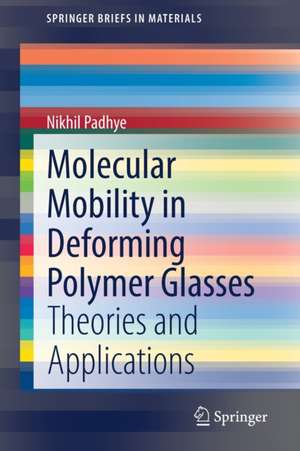Molecular Mobility in Deforming Polymer Glasses: Theories and Applications: SpringerBriefs in Materials
Autor Nikhil Padhyeen Limba Engleză Paperback – 16 oct 2021
Din seria SpringerBriefs in Materials
-
 Preț: 315.57 lei
Preț: 315.57 lei -
 Preț: 346.86 lei
Preț: 346.86 lei -
 Preț: 343.98 lei
Preț: 343.98 lei -
 Preț: 344.90 lei
Preț: 344.90 lei -
 Preț: 357.95 lei
Preț: 357.95 lei -
 Preț: 344.90 lei
Preț: 344.90 lei -
 Preț: 344.90 lei
Preț: 344.90 lei -
 Preț: 394.82 lei
Preț: 394.82 lei -
 Preț: 377.18 lei
Preț: 377.18 lei -
 Preț: 375.23 lei
Preț: 375.23 lei -
 Preț: 380.63 lei
Preț: 380.63 lei -
 Preț: 374.46 lei
Preț: 374.46 lei -
 Preț: 378.92 lei
Preț: 378.92 lei -
 Preț: 378.92 lei
Preț: 378.92 lei -
 Preț: 380.07 lei
Preț: 380.07 lei -
 Preț: 377.18 lei
Preț: 377.18 lei -
 Preț: 343.98 lei
Preț: 343.98 lei -
 Preț: 344.21 lei
Preț: 344.21 lei -
 Preț: 377.18 lei
Preț: 377.18 lei -
 Preț: 376.22 lei
Preț: 376.22 lei -
 Preț: 374.85 lei
Preț: 374.85 lei -
 Preț: 412.30 lei
Preț: 412.30 lei -
 Preț: 377.18 lei
Preț: 377.18 lei -
 Preț: 376.22 lei
Preț: 376.22 lei -
 Preț: 374.08 lei
Preț: 374.08 lei -
 Preț: 445.88 lei
Preț: 445.88 lei -
 Preț: 376.80 lei
Preț: 376.80 lei -
 Preț: 385.47 lei
Preț: 385.47 lei -
 Preț: 377.35 lei
Preț: 377.35 lei -
 Preț: 377.18 lei
Preț: 377.18 lei -
 Preț: 375.45 lei
Preț: 375.45 lei -
 Preț: 377.35 lei
Preț: 377.35 lei -
 Preț: 377.73 lei
Preț: 377.73 lei -
 Preț: 380.07 lei
Preț: 380.07 lei -
 Preț: 380.07 lei
Preț: 380.07 lei -
 Preț: 378.71 lei
Preț: 378.71 lei -
 Preț: 412.30 lei
Preț: 412.30 lei -
 Preț: 380.07 lei
Preț: 380.07 lei -
 Preț: 377.18 lei
Preț: 377.18 lei -
 Preț: 378.71 lei
Preț: 378.71 lei -
 Preț: 377.57 lei
Preț: 377.57 lei -
 Preț: 377.18 lei
Preț: 377.18 lei -
 Preț: 442.24 lei
Preț: 442.24 lei -
 Preț: 378.34 lei
Preț: 378.34 lei -
 Preț: 381.00 lei
Preț: 381.00 lei -
 Preț: 373.32 lei
Preț: 373.32 lei -
 Preț: 376.22 lei
Preț: 376.22 lei -
 Preț: 377.95 lei
Preț: 377.95 lei -
 Preț: 376.80 lei
Preț: 376.80 lei -
 Preț: 376.04 lei
Preț: 376.04 lei
Preț: 377.73 lei
Nou
Puncte Express: 567
Preț estimativ în valută:
72.31€ • 74.41$ • 60.95£
72.31€ • 74.41$ • 60.95£
Carte tipărită la comandă
Livrare economică 01-15 martie
Preluare comenzi: 021 569.72.76
Specificații
ISBN-13: 9783030825584
ISBN-10: 3030825582
Pagini: 103
Ilustrații: XI, 103 p. 73 illus., 70 illus. in color.
Dimensiuni: 155 x 235 mm
Greutate: 0.17 kg
Ediția:1st ed. 2021
Editura: Springer International Publishing
Colecția Springer
Seria SpringerBriefs in Materials
Locul publicării:Cham, Switzerland
ISBN-10: 3030825582
Pagini: 103
Ilustrații: XI, 103 p. 73 illus., 70 illus. in color.
Dimensiuni: 155 x 235 mm
Greutate: 0.17 kg
Ediția:1st ed. 2021
Editura: Springer International Publishing
Colecția Springer
Seria SpringerBriefs in Materials
Locul publicării:Cham, Switzerland
Cuprins
1. Polymer Physics and Dynamics of Polymer Melts.- 2. Structure and Properties of Polymer Glasses.- 3. Physics of Deformation in Polymer Glasses and Deformation- InducedMolecularMobility.- 4. Deformation-Induced Polymer Mobility and Sub-Tg Bonding.- 5. Future outlooks.
Notă biografică
Nikhil Padhye obtained his PhD from the Department of Mechanical Engineering at the Massachusetts Institute of Technology, Cambridge, MA, and Bachelor's-Master's (dual degree) in Mechanical Engineering from the Indian Institute of Technology Kanpur. He also completed his postdoctoral training at Stanford University and University of California Berkeley. His research interests include computational modeling of solids, finite element methods, and polymer mechanics. Recent efforts have focused on developing fundamental understanding of the deformation-induced bonding phenomenon in polymers and its implications for different manufacturing sectors which rely on polymer adhesion.
Textul de pe ultima copertă
This book bridges disparate fields in an exploration of the phenomena and applications surrounding molecular mobility in glassy materials experiencing inelastic deformation. The subjects of plastic deformation and polymer motion/interdiffusion currently belong to the two different fields of continuum mechanics and polymer physics, respectively. However, molecular motion associated with plastic deformation is a key ingredient to gain fundamental understanding, both at the macroscopic and microscopic level. This short monograph provides necessary background in the aforementioned fields before addressing the topic of molecular mobility accompanied by macroscopic inelastic deformation in an accessible and easy-to-understand manner. A new phenomenon of solid-state deformation-induced bonding in polymers is discussed in detail, along with some broad implications in several manufacturing sectors. Open questions pertaining to mechanisms, mechanics, and modeling of deformation-induced bonding in polymers are presented. The book’s clear language and careful explanations will speak to readers of diverse backgrounds.
Caracteristici
Represents the first book dedicated to molecular mobility in deforming glasses Bridges the gap between continuum mechanics/plasticity and microscopic/molecular level motion Contains necessary elementary concepts, rendering this interdisciplinary
